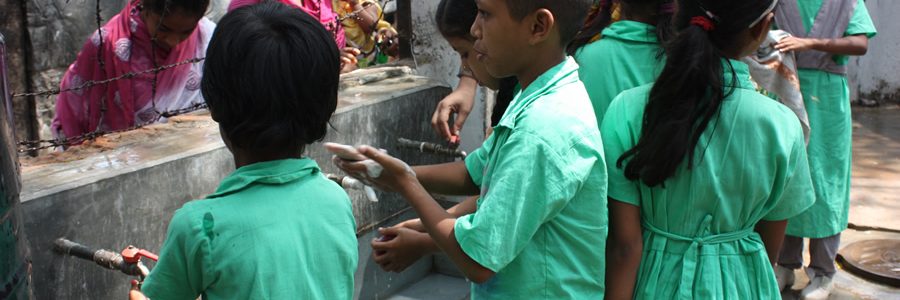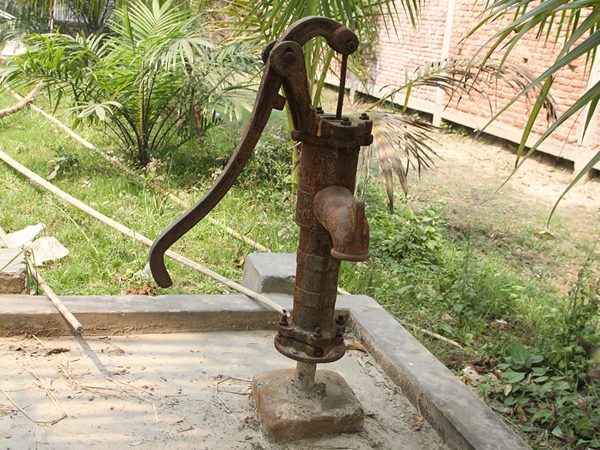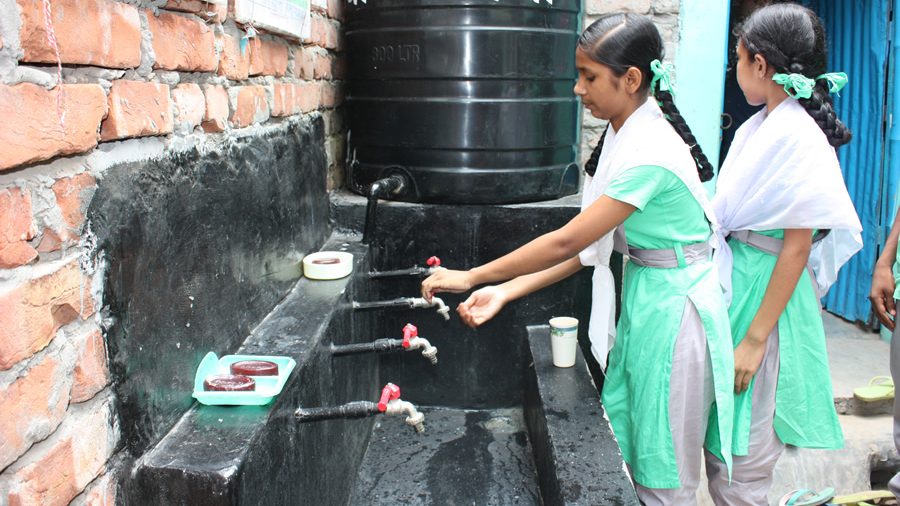Schools: Shikkhaloy Gangatia, Shikkhaloy Talabo, Shikkhaloy Tamat, Shikkhaloy Akhalia, Shikkhaloy Bogajan Shikkhaloy Poddipara, Shikkhaloy Dhalia, Shikkhaloy Lalpur, in Mymensingh, Bangladesh
In collaboration with

June 2014 – May 2016
We installed deep tube wells to supply water to schools where, until now, iodine tablets have been used to purify the water.
Objectives
- Increase access to drinking water in intervention schools.
- Enhance the use of sanitary facilities in intervention schools.
- Promote good hygiene practices in the eight schools of Mymensingh, thus improving the living conditions of their communities.
Beneficiaries
1,567 direct
772 women and 795 children under 15
33,891 indirect
16,609 women, 14,336 children under 15
People living in the communities adjoining the eight schools.

On the ground
There is a high incidence of waterborne diseases in Bangladesh and, consequently, poor school performance and early school leaving.
The provision of drinking water and sanitation and the promotion of good hygiene practices are two of the key public health issues in Bangladesh. 21.22% of the country’s population has at some time been hospitalised in its Upazilla Health Complexes (first-tier public hospitals) due to waterborne diseases. This leads to low school enrolment rates, absenteeism, poor school performance and early school leaving.

In detail
The provision of drinking water and sanitation and the promotion of good hygiene practices are two of the key public health issues in Bangladesh. 21.22% of the country’s population has at some time been hospitalised in its Upazilla Health Complexes (first-tier public hospitals) due to water-borne diseases, mainly diarrhoea and typhoid. The incidence of diarrhoeal disorders among the under-fives is 5% in boys and 4.2% in girls. Only 31.7% of the rural population uses sanitary installations or latrines in their own homes.
Additionally, diseases associated with the lack of access to drinking water and sanitation are a significant contributory factor to low school enrolment rates, absenteeism, poor school performance and early school leaving. Furthermore, the lack of awareness of hygiene, drinking water and sanitation aggravates this situation. Students’ health affects their ability to learn. Improving hygiene conditions, water quality and sanitation in schools encourages an educational environment with a beneficial impact upon children’s health, wellbeing and ability to learn.
This project will provide support for the installation of deep tube wells in schools where, up to now, iodine tablets have been used to treat water for daily use. What’s more, the construction of latrines with a gender focus will ensure that girls will feel comfortable going to the bathroom at school, particularly during their menstrual cycle.
What methodology will be used and what are its advantages?
Existing school and community groups—above all the School Management Committee, the Parents’ Committee and the Health Committee—will participate in the identification of the locations best suited for the construction of the facilities. They will also take part in overseeing the works, which will, as representatives of the local community, provide them with a sense of ownership over the project. The groups will carry out participative oversight of the project to guarantee proper use of the sanitary facilities by students and the community in general.
What social impact will the project have?
The supply of safe and sufficient water will gradually reduce the prevalence of waterborne diseases among students, and this will have a significant knock-on effect on improving their educational performance in the schools. It will also reduce the burden of expenditure on treating families for waterborne diseases, thus impacting the parents’ financial solvency. Additionally, students’ practice of using drinking water and hygienic latrines will directly improve the school environment and thereby contribute to the implementation of proper sanitary and hygiene practices in their own homes. Furthermore, the mass awareness-raising campaign will improve understanding about drinking water and hygienic sanitation, which will help create a feeling of responsibility with regard to health among members of the communities involved.


